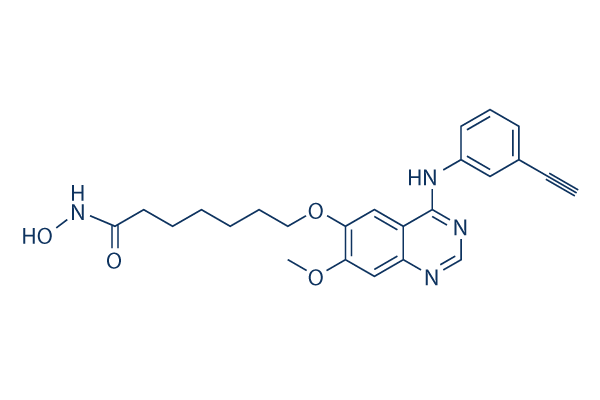| Description: |
CUDC-101 is a potent inhibitor of HDAC, EGFR, and HER2 with IC50s of 4.4, 2.4, and 15.7 nM, respectively. |
| In Vivo: |
CUDC-101 (120 mg/kg, iv, daily) induces tumor regression in the Hep-G2 liver cancer model and is more efficacious than erlotinib at its maximum tolerated dose (MTD). In the erlotinib-resistant A549 NSCLC xenograft model, CUDC-101 (120 mg/kg) shows potent inhibition of tumor growth. In the erlotinib-sensitive H358 NSCLC models, CUDC-101 (15, 30, 60 mg/kg, i.v.) inhibits tumor growth in a dose-dependent manner. CUDC-101 (120 mg/kg) causes significant tumor regression in the lapatinib-resistant, HER2-negative, EGFR-overexpressing MDA-MB-468 breast cancer model and the EGFR-overexpressing CAL-27 head and neck squamous cell carcinoma (HNSCC) model. CUDC-101 (120 mg/kg) also inhibits tumor growth in the K-ras mutant HCT116 colorectal and EGFR/HER2 (neu)-expressing HPAC pancreatic cancer models[1]. In an in vivo mouse model of metastatic ATC, CUDC-101 inhibits tumor growth and metastases, and significantly prolongs survival[3]. CUDC-101 (120 mg/kg) is effective against a broad range of tumor types in xenograft models[4]. |
| In Vitro: |
CUDC-101 inhibits both class I and class II HDACs, but not class III, Sir-type HDACs. CUDC-101 displays broad antiproliferative activity in many human cancer cell types. CUDC-101 is a potent and selective HDAC, EGFR, and HER2 inhibitor with only weak inhibition of the following protein kinases (IC50): KDR (VEGFR2) (849 nM), Src (11000 nM), Lyn (840 nM), Lck (5910 nM), Abl-1 (2890 nM), FGFR-2 (3430 nM), Flt-3 (1500 nM), and Ret (3200 nM)[1]. CUDC-101 (300 nM) inhibits both the full length AR (flAR) and the AR variant AR-V7[2]. CUDC-101 is the most active agent in all three ATC cell lines screened for inhibitors of EGFR and HDACs, with half-maximal inhibitory concentration (IC50) at 0.15 μM for 8505c, and 1.66 μM for both C-643 and SW-1736 cells. CUDC-101 inhibits cancer cell migration and modulates epithelial-mesenchymal transition marker expression in ATC cells. CUDC-101 also inhibits HDAC and MAPK pathway, induces p21, and decreases survivin and XIAP expression in ATC cells[3]. CUDC-101 (1 μM) increases the acetylation of p53 and α-tubulin, nonhistone substrates of HDAC, in treated cancer cells. CUDC-101 modulates RTK activity and expression and exhibits immediate and stable inhibition of RTK and downstream Akt signaling[4]. |






















